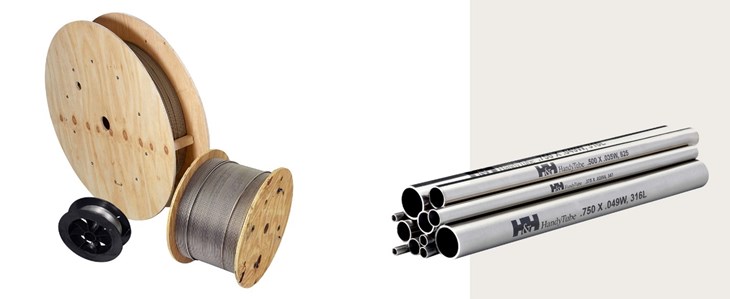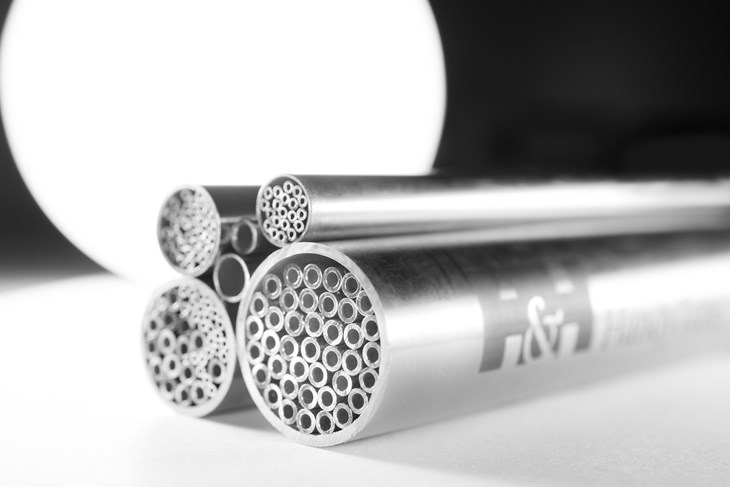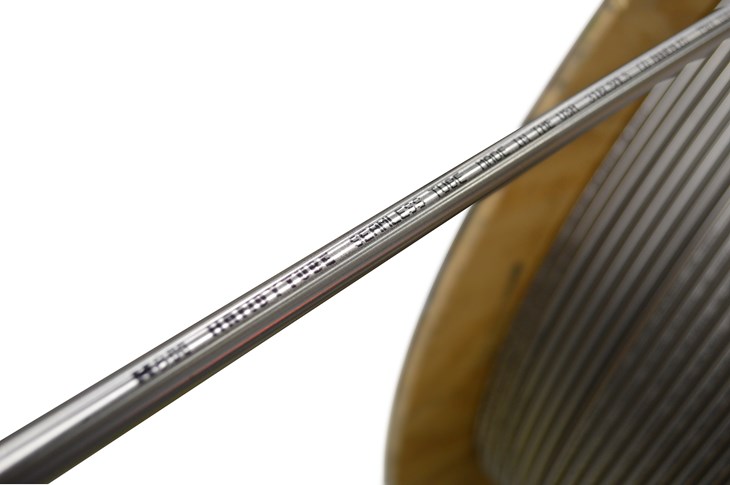Stainless Steel World Americas spoke with Lisa Presutti (President), Dean Hoffmann (Vice President, Sales and Marketing), and Chris Rowland (Vice President and General Manager), about HandyTube’s long and proven history, focus on customer service excellence, and dedication to short delivery times to better serve its wide variety of customers.
By Brittani Schroeder
HandyTube Corporation’s journey began in 1867 with the founding of precious metals company Handy & Harman. In 1892, Handy & Harman was first to set the domestically traded price of silver, and the name is still in use today in the metals stock exchange. At the beginning of the 20th century, the company began to diversify its metals business to include brazing alloys, leading to the 1948 establishment of a tubing division in Norristown, Pennsylvania. Camdel Metals Long Coil Division, founded in Camden, Delaware in 1981, was eventually renamed HandyTube Corporation in 2011.
Steel Partners Holdings L.P. is a diversified global holding company with significant interests in various businesses, such as diversified industrial products, energy, defense, supply chain management and logistics, direct marketing, banking, and youth sports.
“HandyTube’s mission is to be recognized as the global leader in customer service, quality, and delivery in seamless stainless steel and nickel alloy tubing,” says Lisa Presutti.
Manufacturing facilities and capabilities
HandyTube serves domestic and international customers from its Camden headquarters. With warehouses in Texas and Singapore, and a sales office located in Shanghai, China, the company can ensure that all the needs of their global customers are met. “The U.S.A. manufacturing facility is approximately 100,000 square feet, sitting on 11 acres here in Delaware,” says Chris Rowland. “We have a team of 160 people spread across the different locations. With our customer service team located in the same facility as engineering and manufacturing, we can provide feedback to our customers in an accurate and timely manner. This allows significant flexibility in expediting orders and the customization of specific requirements, so our customers receive exactly what they need, when they need it. We also have an ambitious goal to respond to all inquiries within 48 hours.”
To provide customers with the best value and service, the HandyTube manufacturing facility focuses on lean processes: “Lean manufacturing practices provide our customers with high value products by eliminating waste, streamlining processes and decreasing lead times,” explains Rowland.

High performing nickel alloys and ultra small diameter tubing
HandyTube manufactures tubing for a wide range of industries, including oil and gas, chemical processing and instrumentation, alternative energy, life sciences, nuclear power, aerospace, and space exploration. “Our seamless tubing is available in both coils and straights in numerous high-performing, corrosion resistant stainless steel and nickel alloys,” says Dean Hoffmann.
The company offers common 300 series alloys, Alloy 276, Alloy 22, Alloy 400, MP35N, Alloy 825, Alloy 600, Alloy 625 and Alloy 6Mo (UNS S31254) featuring wall thickness up to 3.8 millimeters. Rowland states, “Our tubing can also be coated and encapsulated through our partners.”
HandyTube’s coil tubes feature outer diameters as small as 0.017 inch (0.508 millimeter) and inner diameters as small as 0.003 inch (0.076 millimeter), working up to 1 inch outside diameters and 0.150-inch walls.
HandyTube’s straight length tubing is available in a wide variety of sizes, ranging from outer diameters of 0.017 inch and inner diameters as small as 0.003 inch, up to 0.750 inch outside diameters.
HandyTube’s Ultra-Small Diameter (USD™) capillary tubing for chromatography applications features outside diameters less than 0.0625 inch (1.59 millimeters). “To minimize the risk of cross-contamination and save our customers time, we developed our proprietary Chroma Clean ID™ cleaning process, which removes manufacturing lubricants and other contaminants from the tubing interiors,” explains Hoffmann. “In addition, our Chromat ID™ drawing process provides inside diameter (ID) support during the manufacturing process, which creates smoother, consistently uniform ID surface characteristics.”
The company’s coil and straight length tubing can be used in a wide variety of applications, including:
• Hydrogen fuel cells — hydrogen powered fuel cells versus battery powered in material handling.
• Aerospace and Space Exploration — high-pressure fuel lines and hydraulic systems.
• Heat exchangers — coil-wound heat exchangers.
• Shipbuilding — high-pressure fuel lines and hydraulic control applications.
• Oil and gas — subsea safety valves, (CNG) and liquefied natural gas (LNG) transfer, and chemical injection.
• Chromatography — long length, small diameter coiled tubing is used to plumb many high-precision systems to increase sampling efficiencies.
• Chemical process industry — steam and heat trace bundles.
• Flow measurement and sensing.
• Liquid and gas transfer.

How is seamless tubing made?
Typical methods in the manufacture of seamless stainless-steel tubing include extruding, gun drilling or piercing. “The raw material begins in the form of a hot extruded seamless pipe, and then the material is cold reduced,” explains Hoffmann. “At this point, the raw material is processed through tube reducers known as pilger mills in a long, straight form. Cold pilgering can maintain uniform outside diameters (ODs) and concentric inside diameters (IDs) because of the longitudinal cold-rolling process which reduces the diameter and wall thickness of steel tube in one operation. For specific material types, this process achieves cross-section reductions of more than 90% in a single working cycle.”
Lubricants are used on the OD and ID when reducing the tube, which is then degreased in preparation for annealing. This process typically produces lengths from around 40 feet to 160 feet in length after reduction.
To manufacture coil tubing, straight lengths of tube are cold drawn in coil form on specially designed equipment. As cold drawing reduces the OD, ID and wall thickness, the tube increases in length as the product is drawn. Two main drawing operations are used: floating plug drawing and sink drawing.
Floating plug drawing
is the process in which the tubing is pulled through a conical die and a floating plug is inserted in the ID. The resulting ID and wall thickness are based on the die and plug size. Floating plug drawing produces a more consistent, smooth product, but can only be used on relatively light wall products.
Sink drawing
is the process in which the tubing is pulled through a conical die and the resulting ID and wall thickness are determined based on the drawing and tubing parameters. Sink drawing is used when heavy relative wall thickness is required for high-pressure applications. The ID is typically a bit rougher when compared to floating plug drawing.
“The coils of tube have lubricants on the OD and ID to aid in the drawing processes,” says Rowland. “For most end-use applications (liquid transport, medical, etc.) the lubricant is removed (degreased) from the tube, and this is accomplished in one step in a large solvent degreasing vessel.”
The tubing also undergoes treatments and tests before leaving the manufacturing facility.
Long straight lengths and coils are annealed after cold reducing to remove internal stresses and to restore the crystalline structure of the material to allow for further cold working. The rapid cooling of the annealing process returns the cold-worked, brittle, and hard material to its soft and ductile form. These steps are repeated until the desired dimensions (OD, ID and wall thickness) are achieved. Tubing is manufactured to applicable ASTM standards and fully tested for potential defects before preparation for shipment to the customer.
After the tube is fully formed to the desired specification, it is hydrostatically tested to ensure integrity. “Hydrostatic testing determines and verifies that the tubing meets the specification,” says Hoffmann. “Several types of information can be obtained through this verification process, including key inspection data such as material flaws, mechanical properties and specific hard spots that can fail when hydrogen is present.”
Stainless steel coil tubing can be level wound on spools for shipment or straightened and cut to specific lengths as designated by the customer. HandyTube’s products can be polished and stenciled with pertinent information for lot traceability and manufacturing identification.

HandyTube strives to improve its current manufacturing processes and to develop new products and services that are enhanced by its dedicated team of experienced engineers. “HandyTube has worked successfully with customers worldwide to take products from a raw idea to full implementation of extensive, high quality solutions for critical applications,” Hoffmann relays. “We also work and collaborate with melting mills on new alloys.”
Ultra-Small Diameter (USD) capillary tubing
An example of HandyTube’s continuous research and development is their Ultra-Small Diameter (USD) capillary tubing. This tubing plays a critical role in improving the performance of liquid chromatography and related microfluidics instrumentation. “Industry leaders in these fields require faster, more efficient equipment that can provide high-precision results. Thanks to USD tubing, this competitive edge is now attainable,” explains Rowland. “USD tubing used in these applications must have a clean and smooth inside diameter and be able to withstand high working pressures. Achieving these properties, however, raises some unique challenges because of the small size (less than 0.0625 inch) of the outer diameter.”
USD tubing used in high-precision applications requires a smooth ID surface finish to ensure delivery of high-purity liquid and gas. Achieving proper smoothness depends on two things: how the tube is first drawn and the engineering expertise of the manufacturing supplier. “We have developed proprietary tube-drawing processes and equipment that can draw stainless steel in coil form, resulting in more reliable flow rates and faster sampling cycles,” says Hoffmann.
Impurities in USD tubing left over from the manufacturing process can result in cross-contamination and inaccurate sample readings. HandyTube’s proprietary cleaning methods degrease USD coil tubing several hundred feet long, reducing the amount of cleaning time required by OEMs.
Seamless, economical long-distance tubing for high-pressure applications
HandyTube has an innovative manufacturing process that can produce long lengths of ½, ¾ and 1 inch diameter seamless stainless steel tubing capable of handling working pressures up to 5,500 psi — without any longitudinal or orbital welds — that can be safely and economically installed.
Long-length stainless steel tubing offers compressed natural gas and hydrogen fueling stations many safety and cost advantages. With the right tools, feeding long lengths of coiled large-diameter tubing through conduit, rather than using conventional tubing, not only takes a fraction of the time, reducing labor costs, it is safer, and resists corrosion, has no risk of incurring impurities and requires no maintenance. For safe uncoiling, HandyTube also designed a special field straightener to help users straighten the coil.
Many facilities that transport high-pressure or flammable gases can benefit from HandyTube long-length; large-diameter coiled stainless steel tubing. “Our advanced tube manufacturing capability allows us to achieve coils up to 700 feet in length,” says Hoffmann. “Designers and builders of natural gas fueling stations or hydrogen delivery systems can enjoy increased safety, time, and cost savings.”

HandyTube is an ISO 9001-certified facility and holds many other certifications in shipbuilding and high-pressure applications. “We are well-equipped with the latest testing equipment and trained personnel. We maintain the highest level of integrity regarding traceability throughout our entire manufacturing process. We also independently verify all raw material prior to use by an outside laboratory for verification of chemistry,” explains Presutti. “Our state-of-the art manufacturing laboratory is on-site and climate controlled. Samples are retained from every lot for peace of mind. We perform 100% Positive Material Identification (PMI) prior to shipping, and 100% of all coils are pressure tested.”
HandyTube’s customers are their top priority. “We diligently listen to our customers’ needs and help them solve their problems. We will continue to provide excellent customer service, the best industry lead time, and customized seamless tubing,” says Presutti. “HandyTube is dedicated to exploring new products and services with a team of expert engineers and partners to become a value adding, problem solving, reliable tubing partner.”





